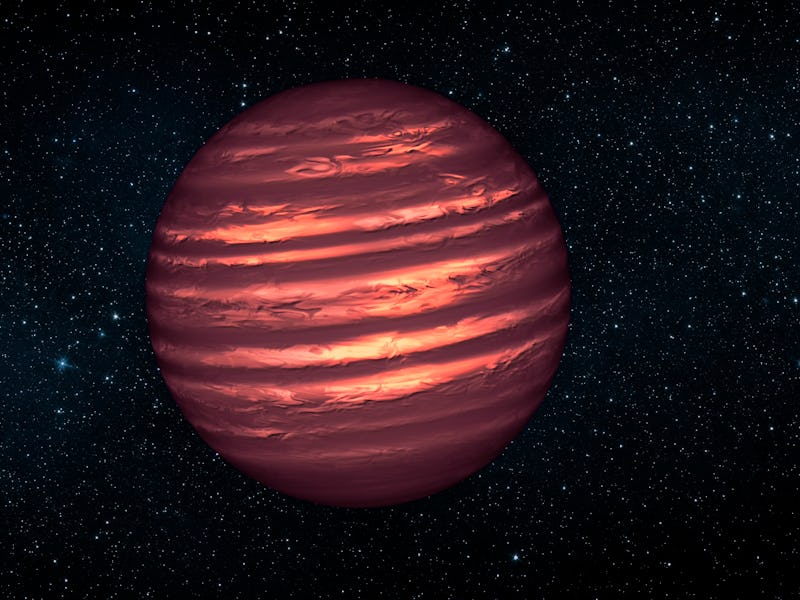Astronomers Are Tracking A "Failed Star" Before It Disappears Behind Its Dead Sun
Astronomers aren't sure if it's a huge planet or a tiny star, but WD 0032-317b could reveal the secrets of more familiar giant planets.

A failed star hotter than our Sun may help us understand the atmospheres of super-hot gas giants.
It’s not always easy to see “ultra-hot Jupiters,” giant planets orbit very close to massive, hot stars, because their fainter infrared light is sometimes lost in the glare of the bright stars they orbit. That’s part of why Weizmann Institute of Science astronomer Na’ama Hallakoun and her colleagues were so excited to find the glowing cinders of a dead star, orbited by an object so massive that it’s nearly a star itself.
WD 0032-317b is so massive that astronomers aren’t actually sure whether it’s the biggest brown dwarf they’ve ever seen or the tiniest star. But Hallakoun and her colleagues say despite almost being a star, this bizarre world can actually help them study the atmospheres of ordinary giant planets orbiting close to big, bright stars.
They published their work in the journal Nature Astronomy.
Failed Star or Overachieving Planet?
This artist’s conception shows what a brown dwarf might look like.
WD 0032-317b is closer to being a star than a gas giant; it’s somewhere between 75 and 88 times the mass of Jupiter, packed into a sphere just a few times larger, which means it’s almost-but-not-quite massive enough to kickstart hydrogen fusion in its core. Astronomers call this kind of “failed star” (or overachieving planet) a brown dwarf, and WD 0032-317b is one of the most massive ones ever discovered.
The brown dwarf orbits a dead stellar core, or white dwarf, which is still blazing hot, probably because the star shed its outer layers only around a million years ago. And the brown dwarf orbits that slowly-cooling stellar core so closely that it’s tidally locked, so one side is constantly blasted with radiation from the white dwarf while the other lies in permanent darkness. When astronomers look at the system through an infrared telescope, the daylit side of the brown dwarf glows with heat at almost 14,000 degrees Fahrenheit — about 4,000 degrees hotter than the surface of our Sun.
Nearly all of that heat comes from the dense, blazing-hot white dwarf the gas giant orbits. Although the white dwarf is less than half as massive as our Sun, it blasts the near side of WD 0032-317b with as much radiation as a Jupiter-like planets would be bathed in by the largest, hottest stars in the universe. The brown dwarf’s nightside is “only” about 3,000 degrees Fahrenheit. That’s a huge temperature difference, and Hallakoun and her colleagues are interested in studying how the atmosphere moves heat around (the answer probably involves howling high-speed winds rushing from the hot side to the cool side).
The brown dwarf is so massive that, depending on what its exact mass turns out to be, it may actually have just begun to fuse hydrogen atoms into helium deep in its center; that inner fusion reactor releases the energy that makes stars burn. But Hallakoun and her colleagues say the difference between a huge brown dwarf and an extremely small star is “merely semantic.” And despite its weirdness, WD 0032-317b could provide a window into the atmospheres of harder-to-see hot Jupiters lost in the glare of their enormous stars.
After all, WD 0032-317b’s atmosphere still has the same composition as most other gas giants. And the white dwarf is small and radiates mostly in ultraviolet and visible light, while the brown dwarf is bulky and glows brightly in infrared wavelengths, so it doesn’t disappear against the light of the star.
Hallakoun and her colleagues hope to watch the brown dwarf as it disappears around the far side of its dead star. They’ll measure the spectrum of light its atmosphere emits and absorbs on the nightside and on the day side. That data, the astronomers hope, will shed some light on how heat moves from the radiation-scorched dayside to the relatively cool nightside. In the process, they’ll learn more about how hot Jupiters’ atmospheres work.